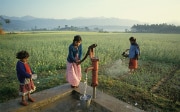
Water is fundamental to life, health, and development. Yet Tajikistan, which has abundant water resources, struggles to supply its people with sufficient safe drinking water and sanitation. As the population in rural areas is thinly spread, the provision of basic services such as health, education, safe drinking water and sanitation is still a big challenge. Tajikistan has the lowest rate of access to safe drinking water in the region.
Switzerland has been supporting the country to develop sustainable water and sanitation systems since 1998. In the villages where the Swiss-funded water program is being implemented, access to safe drinking water has further helped to reduce waterborne diseases such as diarrhoea by more than 50%. Moreover Khujand, the second largest city in the country with a population of 165’000, now also has access to safe drinking water.
The successful operation and maintenance of public infrastructure requires also the necessary know-how and adequate institutions. In rural areas, local communities are therefore being encouraged to set up water users associations –legal entities which are in charge of operating and maintaining the water supply systems. In urban areas, the program provides capacity-building to water utilities to improve their management.
Finally, Switzerland is actively involved in a policy dialogue with the Government on reforms in the water sector. The aim of these reforms in the drinking water sector is to decentralize the responsibility and the financial management for the drinking water providers (utilities in the cities and water user associations in the villages) from the national to the regional level. This shall ensure that they are run in a transparent and efficient way and that they operate in a financially and operationally sustainable manner.
The long term goal is to improve living and health conditions of Tajikistan’s population by ensuring that men, women and children have equal and sustainable access to safe drinking water and sanitation.



